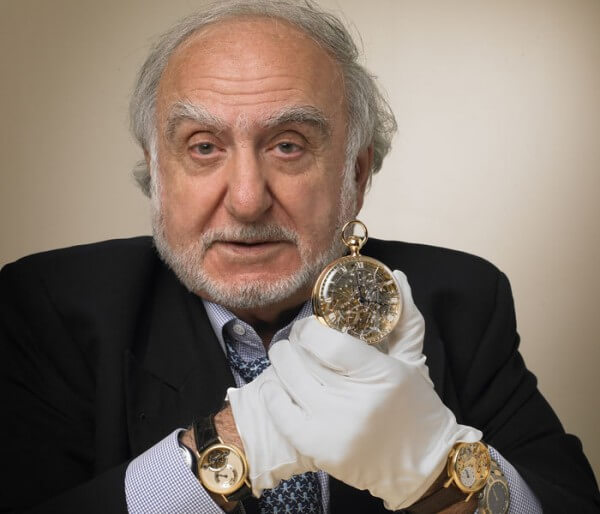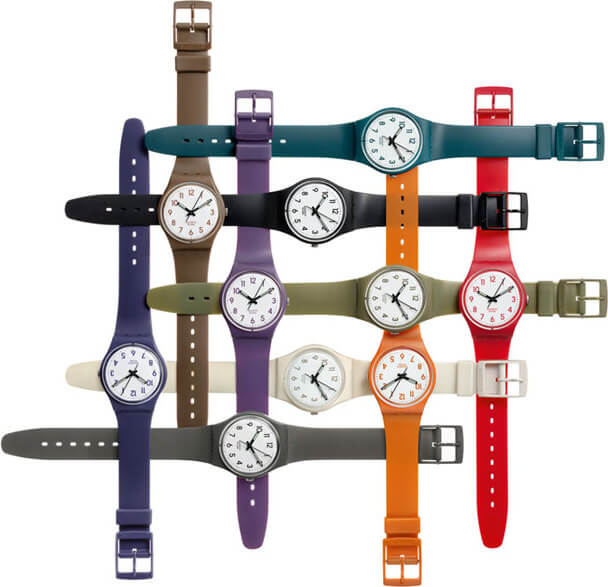Nicolas G Hayek, who died on 28/6/10, aged 82, was born in Beirut on 19/2/28, the second of three children from a Lebanese mother and a Lebanese-American father. His father trained as a dentist in Chicago, his older sister Mona is the widow of the renowned Lebanese architect Joseph Philippe Karam and his younger brother Sam, also a Swiss citizen, is a former CEO of the Swiss group Sibra. His family moved to Switzerland when young Nicolas was seven and in his early twenties, he met his Swiss wife Marianne. They had two children, Nayla and Nick Jr.
Hayek’s entrepreneurial success was firmly rooted in a unique combination of early professional training, flair and charismatic charm. His dry impish humour overlaid his public persona with the engaging quality of humanity. It was reflected in the way he conducted press conferences of the Swatch Group or further understood by visiting the webpage of his consulting company Hayek Engineering Inc.
He will be remembered with humour as the man called Mr Swatch who wore six or more watches up his arms when making the presentations of new brand products. His face was wonderfully fertile material for the caricaturist and the cartoons on his own webpage are testament to the self-knowledge this man had of himself and his public image. Finally, by the end of his extraordinary life, Hayek was counted among the world’s richest men with an estimated net worth of $3.9 billion.

Swiss brands reduced to a shoebox of records
The seeds of Nicolas Hayek’s association with the watch industry date back to the advent of the miniaturised quartz technologies of the seventies which overnight rendered obsolete the bread-and-butter lines of the Swiss-dominated mechanical watch industry. The Seiko 35 SQ Astron was the first quartz watch to enter production in 1969 and this was when the trouble began. The Asian industry spawned by the new cheap quartz technology was the root cause of the catastrophe which assailed the Swiss industry as massive numbers of cheap quartz digitals from Asia quickly flooded the global market. Overnight venerable Swiss brands were reduced to a shoebox of records, victims of the fickle loyalty of superficial novelty and a price-driven market.
By 1980 Japan was second in the world in number of watches produced, after only Hong Kong. The Swiss no longer accounted for any of the inexpensive segment and continued to lose their share in the mid-range, already less than 10% of the world market. Ironically much of the manufacturing equipment, sold for a pittance off the Swiss bankruptcies, found its way to Hong Kong and was the basis of cheap Asian mechanical watch manufacture adding to the misery of the Swiss industry.
Forcing Swiss makers to compete with Asian production
Thus Hayek’s enduring relationship with the Swiss watch industry started in 1983 against this disastrous scenario. At this time, Nicolas G. Hayek, CEO of Hayek Engineering, received an assignment from the worried banks to develop a strategy for the future of ASUAG and SSIH.
It has been widely reported in the recent press that he was hired to compile a report on how the watchmaking industry might best be liquidated. But if this is true then there is absolutely no verifiable evidence to support this in the public arena. Indeed quite contrary to this, in 1983, the resultant Hayek Study recommended a number of measures designed to enable the survival and ultimate recovery of the brand companies. Critical steps included the merger of ASUAG and SSIH into the new SMH and the launching of a mass-produced low-cost, high-tech watch. Hayek’s strategy depended on a revitalization of flagship brands such as Omega and as well, to promote his new, low-priced plastic watch that had been developed under the direction of Ernst Thomke at ASUAG – and now branded as the Swatch watch.
Hayek persuaded the banks that forcing the Swiss makers to compete with Asian production would ultimately be good for the Swiss, because it would force a rationalisation of costs. If they did not seek to regain the volume markets, costs would continue to rise and would bleed into the higher-end segments. Hayek considered that ASUAG and SSIH had a duty to remain Swiss-owned firms maintaining the traditions of Swiss watchmaking. Hayek observed, “We are all global companies competing in global markets. But that does not mean we owe no allegiance to our own societies and cultures.” The expectation was that these strategic goals would yield a Swiss industry that rewarded innovation, and that competed in all segments to restore Switzerland’s proud horological history.
A new culture
The subsequent implementation of the measures in the Hayek Study, together with the takeover of the majority of shares by what is called “the Hayek Pool” and the nomination of Nicolas G. Hayek as CEO, successfully created new opportunities and established a new culture. Hayek instituted a lean, flat corporate structure with little formal hierarchy to encourage innovation. He felt that hierarchies stifled good ideas: “Every single time an idea has to move one step up the corporate ladder of hierarchies, chances are that it won’t advance, or only in a scaled-down version. Hayek believed that “Organizational structure is the most inhuman thing ever invented.” He encouraged employees to come to him directly with their ideas to encourage a more entrepreneurial atmosphere.
Hayek saw his effort to strengthen SMH’s brands as a way to overcome the dehumanization and lack of individuality that he felt organizations could breed. He encouraged employees to identify with their brands and their individual cultures to avoid feeling like cogs in the corporate machine. In a fashion move that simultaneously demonstrated his support for the brands while promoting the kind of unconventional spirit he sought to instil at SMH, Hayek took to wearing multiple watches from all the Swatch Group (former SMH) brands on each wrist – from Swatch up through to Omega. The brands under the Swatch umbrella must of course follow general policy lines laid down by the group but without exception they were given virtually complete autonomy in terms of design, manufacture and promotion strategies.
Breguet, the Swatch Group flagship
Breguet was the brand chosen by Nicolas Hayek as the Swatch Group primary flagship and he declared that he would lift its quality, promotion and image to rival that of Patek Philippe. And to underpin this he took on the management of Breguet as his own private domain. As an aside, it is worth commenting that from time to time serious historical artefacts of Breguet appear in the major auction houses. And Nicolas Hayek has found himself head-to-head with the rival Patek Philippe resulting in bidding wars of great interest to sellers of such items – and some wry smiles from the rest of the world.
Over the next thirty years Hayek re-established the Swiss as watchmakers to the world with market share in all segments but importantly, almost complete domination of the high end where is found the greatest added value potential. During this period Hayek’s flair for the unconventional produced the Swatch car concept which envisioned an automobile that would be just as customizable and affordable as his then enormously popular Swatch watches. What would eventually become the Smart Car was originally a joint venture with Volkswagen that flew under the Swatchmobile banner. It was sold on to Mercedes and Hayek left the Smart Car program after Mercedes-Benz balked at his ideas for a diesel-hybrid model.
Hayek was instrumental as well in the introduction into the iconic Omega brand the Co-axial escapement of George Daniels. Through using radial friction instead of sliding friction at the impulse surfaces the co-axial escapement significantly reduces friction, resulting in longer service intervals and greater accuracy over time. It was a courageous decision as the Swiss lever, which it supplanted, is the culmination of over 240 years of development and serves its purpose extremely well. To replace it with a relative unknown very clearly signals that Hayek knew how to create marketing opportunities out of innovation. It will surely serve Omega for decades after the passing of its mentor.
Hayek’s enthusiasm will remain
Swatch Group’s movement manufactory, ETA, is reported to be fully committed to group production and for some time Nicolas Hayek has been seeking to restrict movements supply to his own Swatch group companies. Concomitantly this too has had beneficial effects on the Swiss industry as the big cashed up brands boost their R&D into the production of their own movements.
Jean-Daniel Pasche, President of the Swiss Watch Industry Federation, believes that today, the brand companies have moved on from their former problems. In an interview with www.swissinfo.ch he said about Nicolas Hayek: “We have lost a great personality and entrepreneur of our industry but we will be able to continue our development and improve our position in global markets. I remain quite confident in the future because Hayek’s enthusiasm will remain.”
Finally, it must be said that very few men justifiably achieve such high iconic status in their own lifetime as that of Nicolas G Hayek. His pivotal involvement in the reconstruction of the Swiss watch industry, from its death throes thirty years ago to its current flourishing prosperity, will be studied, analysed, and emulated as an example to which many may aspire but only a very select few can achieve.















